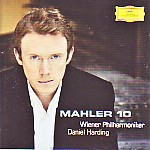The playing of the Vienna Philharmonic on this disc is incredibly beautiful, particularly where you might expect it to be: from the strings and horns. But it’s not Mahler. The shortcomings of Cooke’s performing version are self-evident (and it’s still the best one, on balance): the excessive reliance on the strings and consequent dearth of winds and percussion, the thin textures, and the overly literal treatment of those moments where Mahler does suggest something of the scoring he had in mind (such as the return of the Adagio’s opening theme on horns alone in the finale). Daniel Harding’s contribution to the proceedings, largely limited to producing exceptionally clear textures in the two scherzos, exaggerates all of these defects. Never has this music sounded less like Mahler.
It didn’t have to be this way. Sanderling and Gielen (for example) manage a very convincing approximation of a real Mahler sound, also using Cooke, albeit with some small alterations of their own. Chailly’s orchestra plays just as well, but with far greater intensity and variety of color. In the first scherzo, Harding’s otherwise admirable search for clarity comes at a price: a stiffness of tempo in the quick sections that soon turns mechanical. Similarly, the fourth movement seldom has sounded so disjointed, while Harding skates over the Purgatorio at an excessively swift tempo that robs it of much of its spooky character. Worst of all, despite the rich, lovely tone of the strings in the outer movements, Harding underplays the climaxes and adds insult to injury by permitting the players to get away with some sloppy attacks on those cataclysmic, dissonant chords.
Here’s the bottom line: there is very little positive here that can unambiguously be credited to Harding beyond the basics of keeping everyone together, and the light, clear textures that he secures most of the time. The Vienna Philharmonic cultivates its own special sound; it is not a particularly Mahlerian one. You will listen in vain for some turn of phrase, jet of color, or surprising moment that says “This is Mahler.” Instead, we have a generic Viennese prettiness that the orchestra’s PR department would have us believe qualifies as “authentic style”. This disc, very well recorded and well played though it may be, is neither expressively intense nor particularly idiomatic. Mahler himself said it best: “Tradition is slovenliness.” Here’s proof.
































